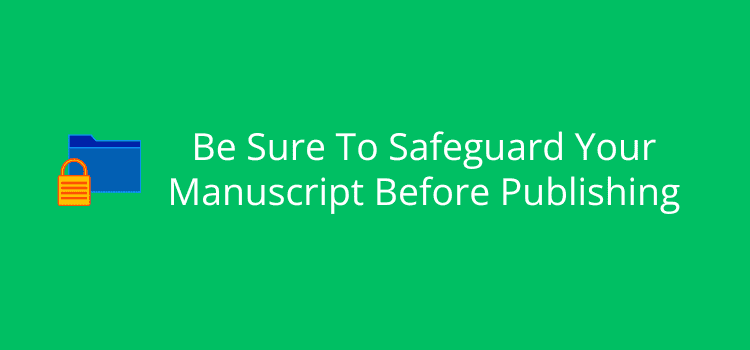
In a world where sharing documents is commonplace, do you give a thought to how to safeguard your manuscript before you publish your book?
Unlike a report or an article draft, your book manuscript is months, or even years, in the making. You are probably careful to protect your manuscript by making regular backups and saving it in multiple locations, such as cloud drives.
However, sharing your hard work online poses risks. You should be very careful about controlling who has access to or receives a copy of your manuscript.
Manuscript theft and copying might not be top of mind for you, but it can happen. That’s why learning how to protect your manuscript is just as important as editing or formatting it.
Why safeguarding your manuscript matters
Getting ready to publish your new book, especially for first-time authors, is an exciting time.
However, some of the steps involved can come with risks. Perhaps you need to provide a copy to an editor, proofreader, or potential publisher. Very often, you might send multiple copies to ARC (advance reader’s copy) readers.
You might also share copies with contacts on social media to act as beta readers to help you get feedback before you publish.
While all this sharing is with good intentions, the need for collaboration and sending your manuscript to strangers can come with serious downsides.
Even for the most careful authors, working online opens the door to threats.
It’s so easy now for those with less than good intent to copy, plagiarize, or even publish the work of others.
You might not realize that trusting the wrong beta reader or posting sample chapters in online forums can lead to trouble.
Online sharing has certainly made it easier for authors to collaborate, but it has also introduced potential pitfalls.
It’s much better to take a few precautions to reduce the possibility of your manuscript ending up in the wrong hands.
You don’t need to go overboard, but being aware of the risks can help you minimize the chances of your manuscript being copied or stolen.
Practical tips for safe manuscript sharing
You can’t lock yourself away if you are working online to get your book ready for publishing.
However, you can be a little more careful in how you work and take precautions to help limit any possible misuse to keep your manuscript safe.
Nothing is truly 100% secure on the Internet, but because it is now how we all work, taking a few extra security measures can reduce many risks.
Here are some simple ways to safeguard your manuscript and keep it safe while still collaborating online.
1. Avoid email attachments
Although it’s convenient, email is the most insecure method of sharing valuable documents.
It’s so easy to make a mistake and send it to the wrong person, or even to multiple addresses. Also, the recipient can forward your attachment to anyone.
A much better way is to use a secure file transfer service. You can find many of these services online, both free and paid.
I use a free, secure service for all my file transfers, and it works perfectly.
2. Limit who sees your work
If possible, you should only share your manuscript with people you can trust. But that’s not always the case if you need beta readers or critique partners.
The best way to manage the possible risks is to keep an accurate record of everyone who you grant access to your manuscript.
You could use a simple spreadsheet to keep a record of the names, email addresses, and dates.
But always be on your guard, and avoid giving complete drafts, especially in DOCX format, to anyone who you are not sure about.
Another option is to prepare your manuscript in EPUB (or MOBI) ebook format. Then, beta readers don’t have the easy option of copying a word processor file.
3. Use secure platforms
If you use cloud storage services, you can usually control who can access your documents.
Services like Google Drive, Dropbox, or OneDrive are probably the most popular.
It’s a convenient way to restrict who can view or download your manuscript.
You can also find specialized manuscript-sharing services online; however, these are rarely free.
4. Set permissions and passwords
Whenever you can, restrict downloading, printing, or editing of your document.
You can also password-protect to secure your manuscript. Most word processors have this option.
If you’re sending copies of your book in PDF, you could add a watermark to every page with your name to deter unauthorized sharing.
You might also add version numbers to help you track who has a particular draft.
5. Avoid public oversharing
Never post full chapters or extensive sections of your manuscript online, even in writing communities or forums.
Sharing excerpts or summaries is not really a problem, but chapters can be copied or distributed without your knowing.
Social media is by far the most risky, so be very careful about what you post.
Manuscript theft can happen

While it’s not something that occurs often on a large scale, it can happen.
One such story involved a former employee of Simon & Schuster who used a sophisticated email phishing strategy to steal over 1,000 unpublished manuscripts of many well-known authors.
Here’s a quote from an article in the Guardian in 2023.
“One day, I created a spoof email address for someone I knew of in the publishing industry, and I sent an email to someone else that I knew of asking for a pre-publication manuscript,” Bernardini said in his statement. “I wrote in the style and using the language that my former colleagues had used. When that request was successful, from that moment on, this behaviour became an obsession, a compulsive behaviour.”
It’s a while ago, but in 2015 the manuscript for the Fifty Shades of Grey prequel was stolen by burglars.
More recently, a Reddit post highlighted that the danger of manuscript theft is still very real. Here’s a partial quote from the post.
“A mutual of mine, (sic) who writes contemporary romance, had her book stolen by an ARC reader, translated into Italian, the ending altered, and then uploaded to Amazon Italy. The thief even created an Instagram account to market the stolen book—using artwork the author had commissioned.
So yes, book theft can happen.”
Another story highlights the security of your devices. The singer-songwriter, Lana Del Rey, had her laptop stolen and had to take quick action to prevent her manuscript from being accessed.
“I had to remotely wipe the computer that had my 200-page book for Simon & Schuster, which I didn’t have backed up on a cloud.”
It might not happen to you, but these quick excerpts should prompt you to be on your guard to prevent manuscript theft.
Avoiding the sharing traps
You can follow all the tips I have noted above, but it’s still easy to make mistakes.
The most common is trusting someone online who you don’t know. You might be so focused on finding beta readers that you let your guard down.
It only takes one person to share your manuscript without your permission to jeopardize your publishing plans. As I mentioned earlier, if you can send your beta readers an ebook copy, it’s safer than an open word processor file.
Another trap can be posting too many excerpts online, thinking it’s not a big deal. Sometimes, even one or two chapters can be enough for plagiarism or to attract shady operators.
With AI today, it’s not inconceivable that someone could use AI to draft a full novel, in your writing style, from your sample chapters.
Basic security is often easy to overlook. You should at least have your manuscript password-protected, even if the only copy is the one on your laptop.
Finally, you should really avoid emailing your manuscript, as it is the easiest way to lose control. If it is unavoidable, at least send a password-protected version, and send the recipient the password via an SMS message.
Taking care to safeguard your manuscript is as much about good judgment as it is about online security.
Always check and evaluate who really needs access. Set clear boundaries for your sharing, and if you are in any doubt, it’s better to be safe than sorry.
Remember, safeguarding your manuscript is about using good judgment as well as security tools.
Summary
If you follow some of the precautions I have mentioned, you can share, collaborate, and get feedback without too much risk.
But safeguarding your work doesn’t mean you should isolate yourself or stay offline.
It only means that you should make deliberate choices about who can access your manuscript, and how and when they can.
Even taking easy, simple steps like password-protecting your files or limiting access can prevent problems and safeguard your manuscript.
You only need to ask yourself this question. Do I really need to share my manuscript with this person?
Related Reading: Free Cloud Writing Apps – 5 Hidden Traps To Avoid
Share This Article


